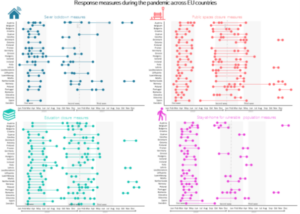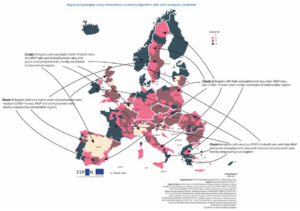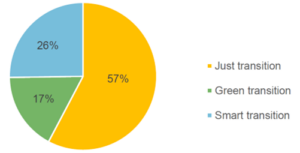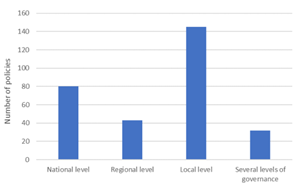The variegated policy response to Covid-19 in European regions

By David Evers, Netherlands Environmental Assessment Agency (PBL), The Netherlands, Sébastien Bourdin, Normandie Business School, France and Guus de Hollander, PBL, The Netherlands
As Covid-19 measures are winding down or have been discontinued, and life for most people seems to be returning to normality – in all its positive and negative senses – it is an apt moment to take stock of how the response to the pandemic affected European regions. We first determine how different types of regions were impacted by and responded to the pandemic. We then discuss whether the crisis was used to implement structural policy reforms to accelerate the just, green, or smart transitions. Research carried out in the ESPON TERRCOV project shows a mixed picture: against a general backdrop of reactive measures, we find evidence of proactive local and regional initiatives, mainly within the social justice sphere. However, whether these will have a lasting effect is far from certain.
No new normal
Throughout Europe, employers are requiring workers to return to offices, traffic congestion on highways is reaching pre-pandemic levels and airports are even more crowded than before. Reshoring of industry and food independence has not materialized has hoped. War has broken out on the Continent and soaring inflation rates and energy prices dominate the policy agenda. The euphoria that the Covid-19 pandemic would force society to fundamentally rethink and drastically reform its broken systems towards something smarter, greener and more equitable/inclusive has dissipated; things are increasingly getting back to the ‘old bad normal’ rather than arriving at a better ‘new normal’. It would seem that we have learned little to nothing from one of the most jarring worldwide crises of a generation. Or have we?
A recently published ESPON report on the territorial impact of Covid-19 in Europe and the policy response in regions and cities (TERRCOV) shows a mixed picture (Bourdin et al., 2022b). In addition to mapping out the spread of the disease over successive waves in Europe and measuring pan-European impacts on indicators such as health, GDP and employment, fourteen regional case studies investigated whether public authorities used the opportunity posed by the crisis to address institutional reforms and accelerate progress towards the just, green and smart transitions (what it calls ‘proactive’ policy). In addition to supplying a wealth of information on specific interventions, the case studies also provide insight into the extent to which regions were able and willing to act. This contribution will examine the evidence produced in the project.
Territorial impacts and response to Covid-19 in Europe
Different regions of Europe have been affected by the pandemic at different times and to different degrees (Bourdin et al., 2022b). During the first wave, Covid-19 mortality started to rise first in Southern Europe, followed by the British Isles and other parts of Western Europe. During the second wave, East-Central Europe was the most affected. In addition to macroregional differences, there were notable urban-rural differences. In contrast with the first wave, the second, third and fourth waves caused above-average excess mortality in predominantly rural regions.
During the different waves, member states instigated measures to restrict the spread of the disease, ranging from social distancing to complete lockdowns. Although the media often emphasised differences, particularly the less restrictive approach taken by Sweden during part of the pandemic, a comprehensive overview reveals striking similarities, especially considering that the waves did not strike all countries at the same time.
Figure 1: Response measures during the pandemic across EU countries.

Source: Bourdin et al. (2022b, p. 13)
The combined effects of the pandemic and the measures implemented to combat it had significant economic and social consequences. A review article, for instance, found that “the role of transport and land use, urban nature, public space, facilities and services, housing, and information and communications technology (ICT) in quality of life in cities was transformed during COVID-19” (Mouratidis, 2021). Mariotti (2021) had similar findings for Italy. As the magnitude of the impact is partly a function of economic specialisation and territorial characteristics (Böhme et al., 2020; Böhme & Toptsidou, 2020), it is essential to address how different types of regions were affected. In general, the following patterns were observed:
- economically high-performing regions with negatively affected sectors due to firm embeddedness in international supply/demand chains (e.g., the automotive industry, tourism, culture, air transport).
- lower economically performing regions characterised by a lower GDP per capita, higher rates of people at risk of poverty, and lower accessibility and broadband access (Gaugitsch et al., 2020), with Covid-19 further exacerbating disparities.
- urban regions, vulnerable due to higher population density, dense international links and exposure to global trade/supply chains, a higher concentration of services directly affected by restrictions, higher air pollution, and higher social segregation (with deprived urban areas hit harder) – but having advantages such as generally higher levels of digitalisation and better access to healthcare.
- rural regions, vulnerable due to factors such as higher numbers of elderly people, a higher share of poverty, more limited access to healthcare services and infrastructures (e.g. fewer health workers, hospital beds), lower level of digitalisation/broadband availability, a higher share of low-skilled workers or employed in jobs that cannot be performed from home – but advantages such as generally higher levels of air quality and lower population density; the urban-rural gap has the potential of widening further after the crisis, particularly in terms of GDP per capita, productivity levels and service delivery (Kah et al., 2020). isolated regions (e.g. islands) are affected by cuts in connectivity (e.g. flight connections) and supply chain difficulties but may have lower infection levels due to limited travel;
- cross-border regions affected by disruptions to cross-border traffic, trade, commute and economic, institutional, social and cultural cooperation due to Covid-19 restrictions; and
- tourist regions (including coastal locations and islands, tourism- dependent (large) cities and mountainous areas, particularly highly specialised regions) were heavily hit by the tourism economy crisis.
Taken together, it is possible to distinguish between regions with strong versus weak socio-economic characteristics on the one hand and regions with a high or low impact (Covid-19 mortality rate) on the other. Based on these variables, a cluster analysis was performed (Note: Unemployment growth rates, youth unemployment growth rates, at-risk-of-poverty growth rates, territorial characteristics [predominantly urban and rural and intermediate regions on the one hand, and border regions, on the other hand) and epidemiological characteristics (total number of COVID-19 death rates)]. The results reveal more heterogeneity between countries than within countries, reflecting the importance of the national level in responding to the pandemic. Nevertheless, when mapped out, the clusters reveal a geographical distribution which does not always conform to national borders.
Figure 2: Regional typologies using hierarchical clustering algorithm with soft contiguity constraint.

Source: Bourdin et al. (2022b, p. 53)
In short, even though Europe faced the same virus and largely reacted to it similarly (e.g. school closures, lockdowns, travel restrictions), the distribution of socioeconomic impacts was quite different. Part of this can be attributed to policy.
Policy responses in Europe
Governments throughout Europe introduced far-reaching policy interventions to counteract the effects of Covid-19 restrictions, aimed mainly at protecting the economy from collapse. In addition, the pandemic exposed or exacerbated structural societal weaknesses or challenges, such as income inequality, green transitions and the digital divide. As the crisis put much socioeconomic interaction on hold (e.g., traffic, commerce) and disrupted governance standard operating procedures, it provided a window of opportunity to address these structural issues. We were then interested in whether regions and cities had implemented proactive policies, defined as “measures that try to make [the] best use of the particular socio- economic circumstances to further a specific regional policy and planning goal” (Bourdin et al., 2022b, p. 56).
To investigate this, a survey was sent to 25 nations (475 responses) and 14 in-depth case studies were carried out. The analysis focused on finding policies that went beyond the direct public-health reactions to the pandemic (e.g. social distancing, lockdowns, restriction of movement). Indeed, many measures that were investigated were put in place to mitigate the deleterious side-effects of corona restrictions. The methods consisted of desk research and interviews (about 10 per case).
European Union
According to our definition, the response of the European Union can easily be considered proactive. Its primary instrument, the €806.9 billion NextGenerationEU fund, is described as “a once in a lifetime chance to emerge stronger from the pandemic, transform our economies, create opportunities and jobs for the Europe where we want to live” (European Commission, 2022a). More specifically, it seeks to facilitate the transition to a sustainable economy and promote digitalisation in a socially just manner.
To access the funding (approximately half loans and half grants), member states must draw up a recovery and resilience plan. All member states have submitted a plan (the Netherlands being the last in July 2022), and most have been approved and are being executed. According to the EU scoreboard (European Commission, 2022b), approximately 28% of expenditure was directed at social policy, about 40% toward climate actions and 26% at digitalisation.
National policies
At the member state level, most of the policies can be regarded as reactive and oriented towards public health and the protection of the economy (Bourdin et al., 2022a). There were differences in the extent and effectiveness of interventions. In a comparison of global regions, “No country was prepared for something like Covid-19, but Germany, France, the Netherlands, Finland and Canada were among the best equipped owing to their stable political systems, strong socio- economic structures and solid infrastructure” (Aygün Oğur et al., 2021). In the Netherlands, for example, about € 80 billion was budgeted to manage the crisis, the vast majority of which consisted of measures to protect the economy (Evers & De Hollander, 2022). The (reactive) national responses provided the backdrop against which regions and cities could draw up proactive policies.
Regional and local policies
As a result of the survey and case study analysis, 301 policies were identified, which fell into those contributing to the just, green and smart transition. Most of these were implemented at the local level and concerned social policies.
Figure 3.1: Distribution of proactive policies across the just, green, and smart transition themes.

Source: Bourdin et al. (2022a, p. 12)
Figure 3.2: Proactive policies by the level of governance.

Source: Bourdin et al. (2022a, p. 13)
There were marked differences in the timeframe of these policies. A great majority of just transition policies followed short-term goals, which was unsurprising given that these were aimed at alleviating the most pressing effects of the pandemic. The policies included income support to businesses (to prevent unemployment) and to vulnerable groups or activities to reduce loneliness. The opposite was true for green and smart transition policies: these pursued medium or long-term goals. For instance, measures to create new green spaces, maintain existing parks, support sustainable tourism, or promote public transport use all have a longer time horizon. Policies with a more short-term character included temporarily reduced fees for bike-sharing systems to encourage people to cycle during the pandemic or the provision of digital equipment for low-income families. Of the 301 policies, 38 were identified as best practices (17 just, nine green and 12 smart). These are listed in the table below, and a short description of each is available in the corresponding ESPON report (Bourdin et al., 2022a).
| Just transition | Green transition | Smart transition |
| Additional outside seating areas in Athens restaurants and cafés
Financial support for the self-employed in Amsterdam Electronic Apps for Lombardy restaurants and cafes Barcelona Housing support for homeless and vulnerable families Réunion food support Mayotte water provision infrastructure Barcelona Elderly Support Veszprem Child Support Hannover youth organisations Access to sports infrastructure in Barcelona Culture Vouchers Helsinki Psychological support Iasi Mental health support Helsinki Malmo Digital Communication Platform Information campaign for religious groups in Barcelona Student tutorials in Amsterdam Social care training in Elvas |
Veszprém Green processes support for businesses
Malmö Transition Crisis Package Zero Strategy Barcelona Athens energy saving programme Iasi bike sharing initiative Veszprém Parks Initiative Helsinki circular economy cluster Barcelona domestic waste management project Amsterdam regional resilience project |
The digital city centre in Corsica
Support for the digitalization of municipal markets in Barcelona Amsterdam ethics of digital health project Azores computers for students drive Mayotte digital access points Iasi e-ticketing infrastructures Elvas home office digital equipment provision Milan new software and digital portals Online Tax Payments in Iasi Amsterdam crowd monitoring system Hannover dashboard Researcher dialogue platform in Helsinki |
Discussion
According to the evidence amassed in the ESPON TERRCOV project, the popular claim that Covid-19 affects everyone alike is patently untrue: the impacts of the pandemic were found to be asymmetrical and tended to fall hardest on the weakest in society. The differences in fortunes between European regions were partly a result of territorial (dis)advantages and partly a result of conscious policy. These two are of course related: regions with the most vital starting point could also mobilise the most resistance.
In this crisis, societies found themselves burdened not only by the virus, but by the restrictive measures deployed to combat it. Public authorities can be forgiven for focusing on mitigating the most grievous and urgent impacts and attempting to return things to normal rather than trying to seize an opportunity to implement policies for the long term. Nevertheless, we found hundreds of examples where this occurred, although many were not necessarily intended as proactive and many have already been discontinued. In other cases, proactive measures became incorporated into more durable policy infrastructure. The long-term spatial strategy of Amsterdam, for example, was used as a framework to place short-term initiatives launched during the pandemic. In other countries, an explicit link was made to the national recovery plan and the corresponding European funding. As things slowly return to normal, it remains to be seen how much we have learned from the crisis and whether the pledges to act differently and reform our broken systems will be kept.
References
Aygün Oğur, A., Kurt Özman, E., Özdemi̇r, Z., 2021. Harnessing Covid-19 Experiences in Pandemic Regions for a Tentative Framework of Urban Resilience. Regions 1, 1–16.
Böhme, K., Besana, F., Lüer, C., Holstein, F., Hans, S., Valenza, A., Caillaud, B., Derszniak-Noirjean, M., 2020. Potential impacts of COVID-19 on regions and cities of the EU. European Committee of the Regions, Brussels.
Böhme, K., Toptsidou, M., 2020. Scenario snapshots of a post-COVID-19 EU: Recovery strategies shaping new normals. Spat. Foresight Brief. 2020.
Bourdin, S., Hachaichi, M., Moodie, J., Sánchez Gassen, N., 2022a. Cross-case Synthesis Report: Territorial impacts of COVID-19 and policy answers in European regions and cities (TERRCOV) (Synthesis Report). ESPON, Luxembourg.
Bourdin, S., Hachaichi, M., Moodie, J., Sánchez Gassen, N., Igari, A., Lőcsei, H., Mounir, A., Arcuri, G., 2022b. Territorial impacts of COVID-19 and policy answers in European regions and cities (TERRCOV) (Final Report). ESPON, Luxembourg.
European Commission, 2022a. Recovery plan for Europe. Eur. Comm.
European Commission, 2022b. Recovery and Resilience Scoreboard.
Evers, D., De Hollander, G., 2022. City of Amsterdam: Territorial impacts of COVID-19 and policy answers in European regions and cities (TERRCOV) (Final Report). ESPON, Luxembourg.
Gaugitsch, R., Dallhammer, E., Schuh, B., Hui-Hsiung, C., Besana, F., 2020. Territorial impact assessment: the state of the cities and regions in the COVID 19 crisis. European Committee of the Regions, Brussels.
Mariotti, I., 2021. Is remote working emptying the city? Regions 1.
Mouratidis, K., 2021. How COVID-19 reshaped quality of life in cities: A synthesis and implications for urban planning. Land Use Policy 111, 105772.